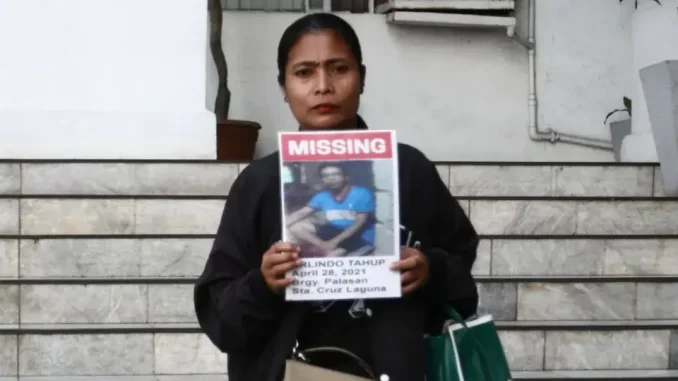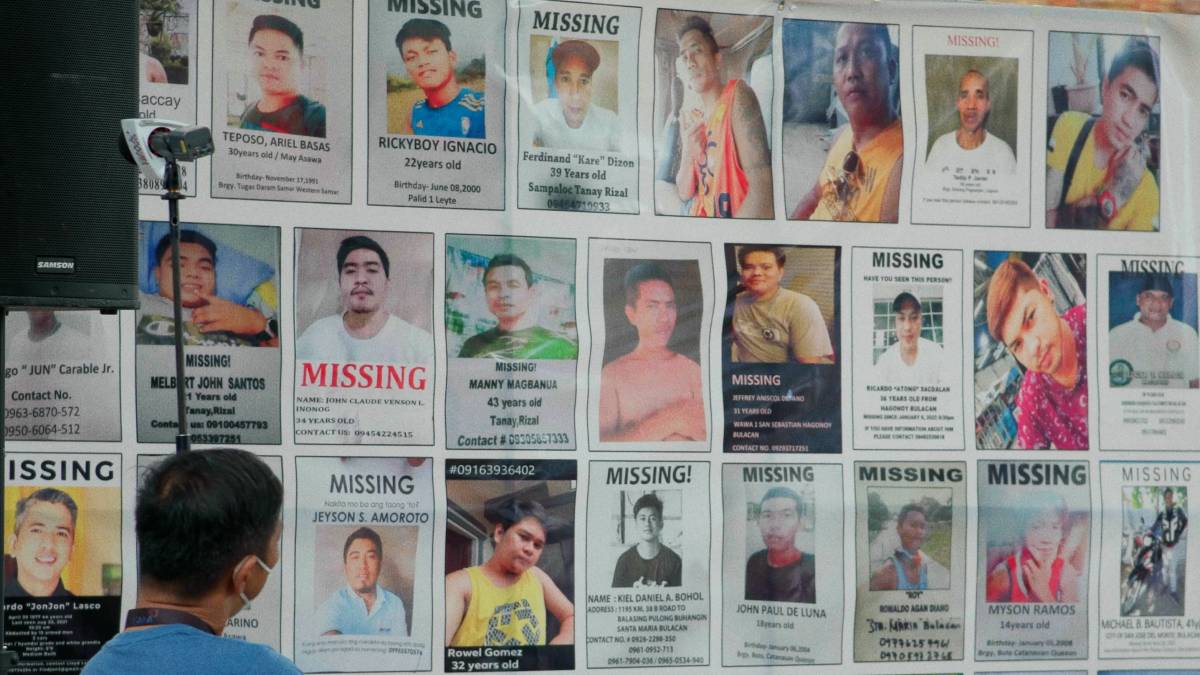
A relative of one of the 34 missing sabungeros before a meeting with the Department of Justice on July 4. Photo by Ben Pulta/Philippine News Agency Facebook
| Published July 12, 2025
As authorities continue their investigation into the missing sabungeros case, 15 cops are in custody while the DOJ prepares for the search for the 34 bodies allegedly dumped in Taal Lake
Inside the Disappearance of the “Missing Sabungeros”: A Deepening Crisis of Trust
In what has become one of the most unsettling sagas in recent Philippine history, the mystery of the missing sabungeros — cockfighting enthusiasts who vanished between 2021 and 2022 — continues to haunt families, stir public outrage, and test the country’s justice system. Nearly three years after the first reports emerged, the disappearance of 34 men linked to online “e-sabong” operations remains unsolved, despite a string of investigations, whistleblower testimonies, and even allegations involving police officers and a former judge.
A Case That Shook a Nation
What began as sporadic reports of missing men connected to cockfighting arenas has since ballooned into one of the most disturbing unsolved cases in recent Philippine memory. Between April 2021 and January 2022, 34 men, many of them breadwinners and fathers, disappeared without a trace. All were linked to “e-sabong” — the booming online cockfighting industry that had grown immensely during the pandemic, generating billions in monthly revenues.
The disappearances did not follow a single pattern — but bore chilling similarities. Victims were last seen being picked up outside cockpits, forcibly taken from vehicles, or walking toward meetings they never returned from. In one of the most haunting CCTV footages aired publicly, a group of men was seen being escorted out of a cockfighting arena by individuals who appeared to be in plainclothes but acted with confidence — as if part of an organized operation.
Many suspected that the victims were either involved in or had knowledge of match-fixing, internal financial disputes, or underground betting syndicates. But what made the case more disturbing was that the abductors operated with military-like precision — fueling fears that rogue elements within law enforcement or the gambling sector were orchestrating the disappearances.
As these reports mounted, the public outcry grew louder. Families staged protests, pleading for government intervention. Netizens launched campaigns under hashtags like #JusticeForSabungeros. The Senate called multiple hearings, and then-President Duterte — initially reluctant to curb the billion-peso industry — finally banned online sabong in May 2022, calling it a “social menace.”
But for the families, the ban came too late. The damage was done, and justice was nowhere in sight.
This was more than just a crime story. It tapped into deeper anxieties about the state of public safety, the reach of gambling syndicates, and the troubling possibility that even police officers and judges could be compromised. Each new development didn’t bring closure — it exposed more cracks in a system many Filipinos were already losing faith in.

images of the missing sabungeros
Whistleblower Revelations and Protective Custody
After more than two years of stalled leads, dead ends, and public frustration, a significant breakthrough emerged — and it came not from forensics, but from a man who finally decided to speak.
Known only by his alias “Totoy,” the whistleblower came forward with chilling details about what he claims really happened to several of the 34 missing sabungeros. His identity remains protected, not only for his safety but also for the integrity of the investigation. The Philippine National Police (PNP) swiftly placed him under protective custody, citing credible threats to his life.
Totoy allegedly worked closely with some of the men involved in the illegal online sabong operations and may have direct knowledge of the planning, abductions, and possible executions. While official details remain confidential, leaks and news reports suggest that Totoy named names — including individuals in uniform and possibly even higher-ups in the e-sabong network.
According to sources, Totoy had been in hiding for months before finally surrendering to authorities. His motivation? A mix of fear, guilt, and a growing sense that “the truth needed to come out,” as reported by Philstar.
His testimony could be the key to unlocking the truth behind the disappearances — but it comes with immense risk. In cases like this, whistleblowers often face grave retaliation, especially when their statements threaten to bring down people in positions of power or expose links between organized crime and law enforcement.
In fact, prior to Totoy’s appearance, at least one other witness had reportedly gone silent after receiving threats. This history of intimidation only underscores the gravity of the case — and the need for institutional protection for those brave enough to break the silence.
For the families of the missing men, Totoy’s emergence offers a rare flicker of hope. His willingness to testify — even anonymously — suggests that the truth may not be buried forever. And for the investigators, it presents a new and critical challenge: Can they ensure justice in a system many fear is compromised?
This isn’t just about one man’s word — it’s about whether the Philippine justice system is strong enough, or clean enough, to pursue the truth wherever it leads.
🎥 Video Breakdown
Hosted by Philippine media, the clip reports on developing allegations that a PNP (Philippine National Police) colonel may be entangled in the missing sabungeros case. Here’s a detailed explanation:
-
Accusation of Police Involvement
The video highlights a police commission statement suggesting that several PNP personnel could be complicit in the disappearances of the 34 men. The involvement of a high-ranking officer, possibly a colonel, is under scrutiny -
Napolcom’s Response
The National Police Commission (Napolcom) acknowledges the seriousness of these allegations and indicates that they’re investigating — signaling recognition at the institutional level -
Context During E‑Sabong Hearings
These revelations come amid broader Senate inquiries into e‑sabong— where anonymous witnesses and whistleblowers point to coordination between gambling syndicates and corrupt law enforcers. -
Public Trust at Stake
The core concern expressed in the video is the erosion of public trust in law enforcement. If true, it confirms fears that the very people meant to uphold the law might instead be aiding forced disappearances.
Hope Amid the Horror
For the families of the 34 missing sabungeros, the last few years have been a never-ending cycle of heartbreak, waiting, and unanswered questions. Birthdays have passed, anniversaries have gone uncelebrated, and chairs at dinner tables have remained painfully empty. Yet through it all, many have refused to give up hope — clinging to the belief that one day, the truth will surface and that the remains of their loved ones might finally be brought home.
That fragile hope was recently reignited when a second witness, also placed under protective custody, gave a powerful statement to ABS-CBN News. The whistleblower, whose identity remains undisclosed for safety reasons, expressed a deep desire to see justice done — and voiced confidence that the remains of the sabungeros could soon be found.
“We owe it to their families to bring closure,” the witness said. “They deserve to be laid to rest with dignity.”
For many, this was the first credible sign in years that the victims might not be lost forever — that they may not simply vanish into statistics or news clippings, but be found, identified, and honored.
The raw emotion behind this statement resonated deeply with the public. These weren’t just gamblers or nameless victims of a seedy underworld — they were sons, brothers, fathers. They were men who had made mistakes, perhaps, but didn’t deserve to vanish without a trace.
Behind the scenes, sources say investigators are now quietly reviewing potential burial sites, possibly based on leads from the whistleblowers. While authorities remain tight-lipped to protect the investigation’s integrity, the renewed momentum is giving families reason — however cautious — to believe that answers are finally within reach.
But hope, in this case, is a double-edged sword.
Families are preparing themselves for the possibility that their loved ones may never be found — or that what remains is too little to give them the closure they’ve longed for. Some worry the renewed attention could lead to more cover-ups, or worse, retaliation against witnesses that could once again stall the search for truth.
Still, hope remains a powerful force. It has kept families going through years of despair. It has mobilized communities, inspired lawmakers to act, and now, it’s giving momentum to what could be the final push in uncovering the full story.
And in a country where many cases go unsolved, and justice often moves slowly — if at all — even the faintest sign of truth breaking through the darkness feels like a victory.
⚖️ New Twist: Bodies Possibly in Taal Lake
DOJ Secretary Jesus Crispin Remulla addressed the media, confirming that these claims are now being carefully vetted. He emphasized the seriousness of the tip, calling it the most specific and actionable lead the department has received in years.
“The location of Taal Lake is being evaluated. If the information is true, we need to act on it with urgency,” Remulla said.
What makes the claim especially disturbing is that Taal Lake, with depths reaching over 100 meters, is not only geologically unstable but also highly acidic due to its volcanic nature. These extreme conditions make forensic recovery extremely difficult, and also raise concerns that evidence could be permanently destroyed or degraded over time.
⚠️ Japan’s Help Sought
Because of these challenges, the Philippine government has formally requested technical assistance from Japan, asking for remotely operated underwater vehicles (ROVs) and sonar-mapping technology to help search the suspected disposal zones. This is one of the rare instances in a Philippine criminal investigation where foreign marine technology is being brought in to assist in a domestic case.
The move underscores the technical limitations of local agencies in underwater forensics and the unprecedented scale of the possible crime scene.
🧪 Forensic Challenge
If the claims are accurate, locating the remains in such an environment will be difficult — but not impossible. Experts say human remains may still be recoverable if sealed in containers or weighted down. Advanced techniques such as DNA testing, isotope analysis, and even micro-plastics residue could help confirm identities and causes of death — provided the bodies or body parts are intact enough for sampling.
A Shadow Over the Judiciary
Just when the public thought the missing sabungeros case couldn’t get darker, a new and deeply unsettling development emerged: allegations of judicial involvement.
In July 2025, the Supreme Court of the Philippines confirmed it is investigating a former judge over their alleged role in the disappearance of the 34 e-sabong players. While court officials have not publicly disclosed the judge’s identity or specific actions under scrutiny, the very mention of such involvement sent shockwaves through the legal and political community.
This is a profound shift. Until now, suspicions had largely centered on law enforcement officers possibly working with or for illegal gambling syndicates. But the potential complicity of someone within the judiciary — the very institution tasked with delivering justice — introduces a whole new layer of mistrust.
The Supreme Court’s administrative probe suggests that the former judge may have had improper connections to powerful individuals involved in the e-sabong trade. Some legal insiders hint at possible actions such as influencing case outcomes, obstructing investigations, or even facilitating the release or protection of suspects. If proven true, such misconduct would point to institutional rot far deeper than previously feared.
The investigation also raises disturbing questions:
-
How many other officials may be involved?
-
How far has the corruption spread within institutions that are supposed to uphold the law?
-
And most troubling of all — can the justice system credibly prosecute one of its own?
For the families of the victims, the idea that a member of the judiciary might have had a hand — directly or indirectly — in covering up or enabling these crimes is devastating. Many already felt abandoned by the justice system. This revelation risks turning that disappointment into complete disillusionment.
To its credit, the Supreme Court has vowed to act decisively if wrongdoing is proven. Spokesperson Atty. Camille Ting said, “The judiciary will not tolerate any action that undermines public trust.” But critics argue that transparency is crucial. Any hint of secrecy or delay in the process may only reinforce public suspicions of a cover-up.
This development now places the sabungeros case at the intersection of criminality and institutional integrity. It’s no longer just about tracking down abductors — it’s about cleaning house in agencies and offices once thought untouchable.
In a country where political and judicial impunity has long been a sore spot, the investigation into the ex-judge is not just about accountability — it’s about restoring faith in a system that many believe has failed the very people it was built to protect.
 Implications: A Crisis That Cuts Deep
Implications: A Crisis That Cuts Deep
The case of the missing sabungeros is no longer just about 34 vanished men — it has become a mirror reflecting the deeper fractures within the Philippine justice system, governance, and public trust. As the investigation drags on and more layers of alleged corruption are peeled back, the implications extend far beyond the families of the victims.
1. Erosion of Public Trust in Law Enforcement and the Judiciary
The involvement — or at the very least, the alleged complicity — of police officers and a former judge has significantly damaged public confidence in institutions meant to protect the people. When those in uniform are suspected of being part of abduction rings, and when even the judiciary is not beyond scrutiny, citizens begin to ask:
“If the courts and police can’t be trusted, who can we turn to for justice?”
This breakdown of institutional trust could have long-term consequences — making it harder for witnesses to come forward, for victims to file complaints, or for communities to cooperate with authorities.
2. Dangerous Precedent for Impunity
The slow pace of resolution, despite Senate hearings, media coverage, and whistleblower testimonies, sets a dangerous precedent: that even highly publicized disappearances involving known criminal networks can remain unresolved if powerful individuals are involved. This emboldens future abuses, signaling that if the right people are protected, crimes can be committed without consequence.
3. Online Gambling and Unregulated Economies
The e-sabong boom during the pandemic highlighted how unregulated digital industries can spiral out of control, becoming hubs for criminal activity. The billions generated through online sabong attracted not just bettors, but also syndicates and corrupt insiders. Without proper oversight, these platforms turned into breeding grounds for violence, debt disputes, and extortion — with the sabungeros caught in the crossfire.
Even with e-sabong banned, the lesson remains: unchecked digital gambling can be weaponized by criminal interests unless strict policies and enforcement mechanisms are in place.
4. Human Rights and Witness Protection Gaps
The case has also highlighted serious shortcomings in witness protection and whistleblower support. Fear of reprisal has kept many from speaking out. The few who have dared — like “Totoy” — have needed intense protective custody just to survive. This raises urgent questions about how safe it is to tell the truth in the Philippines, especially when it involves implicating those in power.
5. Moral Reckoning for Society
Finally, this case forces a moral reckoning: How did a form of entertainment rooted in tradition — sabong — evolve into an industry so corrupted that it swallowed men whole? How did families go years without answers, while state officials remained tight-lipped? Why was action only taken once the story reached media saturation?
It underscores how apathy, profit, and corruption can thrive when accountability is not enforced — and how victims are often forgotten unless public outrage keeps their names alive.
 Overall Takeaway: The Disappearance That Won’t Disappear
Overall Takeaway: The Disappearance That Won’t Disappear
The mystery of the missing sabungeros is not just a criminal case — it’s a national trauma. What began as a search for 34 men has evolved into a confrontation with deeper issues: state accountability, institutional rot, and the quiet normalization of impunity. Each new revelation — a whistleblower’s testimony, a judge under investigation, a mother’s plea — peels back another layer of a society grappling with the question: What happens when justice is delayed, and truth is buried?
For the families, hope persists, but so does the pain. They’ve waited for answers that remain elusive, while the system meant to serve them seems to bend — or break — under the weight of corruption and fear. Their grief has become a symbol of something larger: the long, uphill battle for transparency, accountability, and justice in the Philippines.
This case will not — and must not — fade quietly from public memory. The sabungeros may still be missing, but their absence has ignited a reckoning. And unless those responsible are held to account, the silence that swallowed them will continue to threaten others.
In the end, this story isn’t just about the missing — it’s about those left behind, and whether their cries for justice will finally be heard.





Be the first to comment